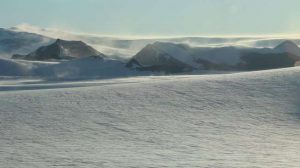
Scientists at EPFL and SLF describe with precision how snow and sand surfaces erode when exposed to wind. Their description can contribute to better predictions of dust emissions from deserts and snow transport in Antarctica, and can be adapted to other planets.
Wind and water transport a multitude of particles with them, leading to erosion or deposits, like dust emissions from the Saharan desert that can reach Europe and snow transport that can… block traffic.
Francesco Comola and Michael Lehning from EPFL and SLF accurately describe how wind flow affects a generic surface of non-homogeneous particles, like snow or sand, using a new theory that will one day help improve weather predictions. The results are now available in Vol. 44, No. 3 of Geophysical Research Letters.
Descriptions of wind or water transport already exist, but this is the first time that fundamental laws – Newton’s second law and energy conservation – are used to describe how particles are ejected from a bed of particles.
“It is a milestone since it is astonishing that the particle ejection process has never been described thus far by using the fundamental conservation laws,” says Lehning, “at least not for a wide range of sediments from heterogeneous sand to snow.”
The new theory is powerful enough so that they can statistically predict the number of particles ejected from the surface of the particle bed and lifted into the flow, even for varying particle sizes and varying material or flow properties.
The theory can be seen as a generalization of how billiard balls are scattered by the white ball during that first hit. But in many ways, the billiard table is a trivial case compared to beds of particles in nature. Instead of having a bed of only 15 billiard balls, the model can handle large numbers of particles and therefore be applied to vast areas on Earth or other planets. Instead of having only one white ball, there can be many incident particles. Instead of having billiard balls all of the same shape and size, the particles can be a mix of shapes and sizes like what we see in a handful of sand or snow. Instead of billiard balls that neither attract nor repulse each other, the particles can be sticky due to cohesive forces, like wet sand or humid snow.
The scientists believe that their new model will advance the study of dune and ripple development, both in arid and polar regions. It will also contribute to improve predictions of dust emissions from deserts and snow transport in Antarctica, whose effects extend from global health to weather and climate change. The model can also help find the cause of the intense sand transport activity observed on Mars, where the low density of the atmosphere would suggest that winds are not sufficiently strong to erode surface particles.
Reference:
Francesco Comola et al. Energy- and momentum-conserving model of splash entrainment in sand and snow saltation, Geophysical Research Letters (2017). DOI: 10.1002/2016GL071822
Note: The above post is reprinted from materials provided by Ecole Polytechnique Federale de Lausanne.










